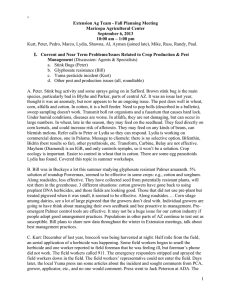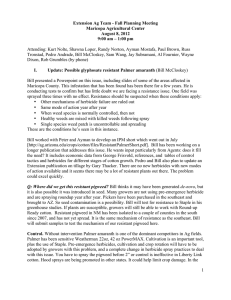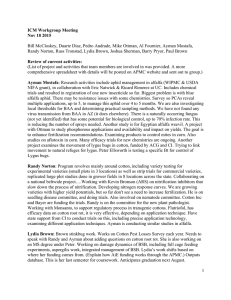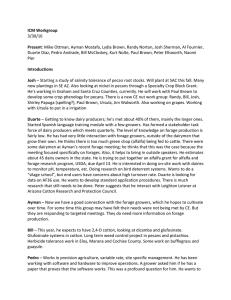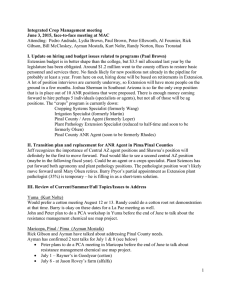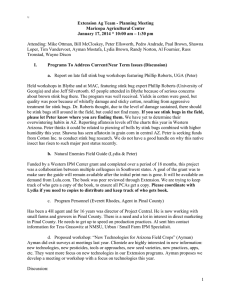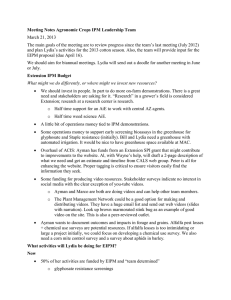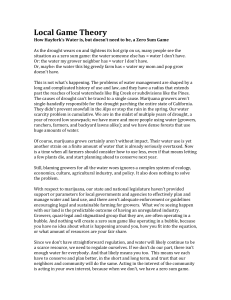Extension Ag Team - Fall Planning Meeting Maricopa Agricultural Center
advertisement
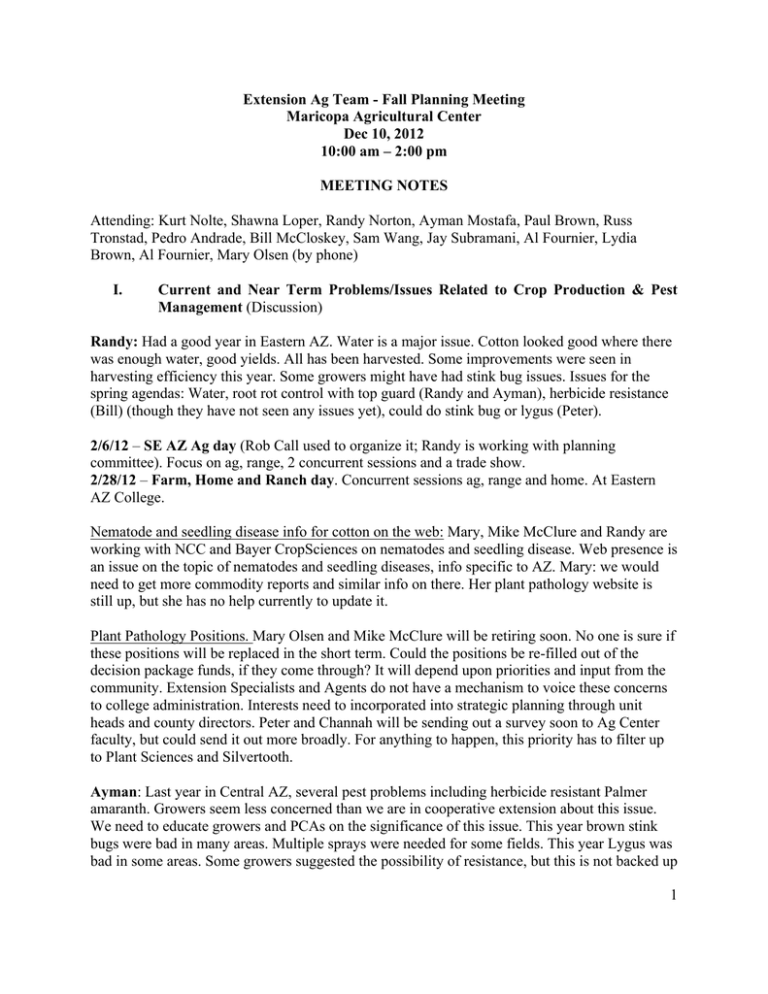
Extension Ag Team - Fall Planning Meeting Maricopa Agricultural Center Dec 10, 2012 10:00 am – 2:00 pm MEETING NOTES Attending: Kurt Nolte, Shawna Loper, Randy Norton, Ayman Mostafa, Paul Brown, Russ Tronstad, Pedro Andrade, Bill McCloskey, Sam Wang, Jay Subramani, Al Fournier, Lydia Brown, Al Fournier, Mary Olsen (by phone) I. Current and Near Term Problems/Issues Related to Crop Production & Pest Management (Discussion) Randy: Had a good year in Eastern AZ. Water is a major issue. Cotton looked good where there was enough water, good yields. All has been harvested. Some improvements were seen in harvesting efficiency this year. Some growers might have had stink bug issues. Issues for the spring agendas: Water, root rot control with top guard (Randy and Ayman), herbicide resistance (Bill) (though they have not seen any issues yet), could do stink bug or lygus (Peter). 2/6/12 – SE AZ Ag day (Rob Call used to organize it; Randy is working with planning committee). Focus on ag, range, 2 concurrent sessions and a trade show. 2/28/12 – Farm, Home and Ranch day. Concurrent sessions ag, range and home. At Eastern AZ College. Nematode and seedling disease info for cotton on the web: Mary, Mike McClure and Randy are working with NCC and Bayer CropSciences on nematodes and seedling disease. Web presence is an issue on the topic of nematodes and seedling diseases, info specific to AZ. Mary: we would need to get more commodity reports and similar info on there. Her plant pathology website is still up, but she has no help currently to update it. Plant Pathology Positions. Mary Olsen and Mike McClure will be retiring soon. No one is sure if these positions will be replaced in the short term. Could the positions be re-filled out of the decision package funds, if they come through? It will depend upon priorities and input from the community. Extension Specialists and Agents do not have a mechanism to voice these concerns to college administration. Interests need to incorporated into strategic planning through unit heads and county directors. Peter and Channah will be sending out a survey soon to Ag Center faculty, but could send it out more broadly. For anything to happen, this priority has to filter up to Plant Sciences and Silvertooth. Ayman: Last year in Central AZ, several pest problems including herbicide resistant Palmer amaranth. Growers seem less concerned than we are in cooperative extension about this issue. We need to educate growers and PCAs on the significance of this issue. This year brown stink bugs were bad in many areas. Multiple sprays were needed for some fields. This year Lygus was bad in some areas. Some growers suggested the possibility of resistance, but this is not backed up 1 by data from research studies. Weather helped limit these problems; it could have been worse. Ayman is getting a lot of questions about alfalfa production (seed treatments, water use, nutrition, etc.) and pest management. Aside from some work he is doing on Egyptian Alfalfa weevil, there is also concern about potato leaf hopper damaging crops, but we do not have research info on this pest yet. Some growers were concerned about spider mites in corn. Problem is there is not much local research on alfalfa production and pest management. A collaborative effort is needed. Ayman is trying to revive interest in an alfalfa growers association that could help fund research. It was suggested that he talk to Mike Ottman to get a historical perspective. Could they join with another existing group, such as Small Grains association? They are generally different growers. Paul Brown and Mike Ottman have the original notes from meetings held previously (2003-05). Now is a good time to act, because alfalfa prices are up. Acres are up in central AZ. Ayman willing to take the lead in trying to promote development of an alfalfa or forage association. Suggestion: talk to contacts at ag chemical companies. Ayman has secured a sponsor for an alfalfa meeting to move ahead on this issue– maybe at MAC, date TBD. Week of Feb 18 – 2 locations for preseason meetings: Buckeye meeting Eastern Maricopa County meeting Ayman will send a Doodle to the team. Shawna – She has been getting calls from insurance companies indicating that they got a lot of claims for heat stress from Arizona growers this year. Paul had one or two calls this year. Randy in past years saw issues where growers claimed heat stress, but it was really poor watering or management. It was not a year where heat stress should have been an issue. Many growers will be planting less cotton in 2013. Some will be planting guayule, some guar. There are plans for a guar processing plant in California, near Yuma. Yulex built a plant in Southern Phoenix. They imply there will be more guayule contracts in the future. Bridgestone is also interested in guayule for tire production. Shawna has been getting calls on grain corn. There is a lot of interest. Alflatoxin will be an issue. Larry Antilla has in interest in alflatoxin and AF36, which out-competes the toxigenic strains. They might fund a variety trial. Kurt: in Yuma there is also an interest in grain corn. She has a sorghum silage variety project this year, looking at protein levels. The dairy industry is interested in this. It would be beneficial to improve communication between dairymen and growers. Shawna has developed a magnet for cooperative extension locations. She has ordered 500. Let her know if you need some to distribute. Suggestion: make a similar dashboard calendar in the future. 2/26 - Casa Grande mtg 2/27 - Marana mtg Kurt – Cotton harvested in August and Sept. Above average yields, about average on the pest issues. He has received a few calls about alfalfa. He would like an alfalfa talk on Jan 16 and 17 Yuma and Parker meetings. Grain corn interest is up, as is interest in dry bean crops. The 2 vegetable industry is struggling because of the hot fall. This has pushed vegetable production forward – lettuce is being harvested early and prices are way down. Growers are losing money on production. If there is a sudden cold storm, there could be gaps in availability and prices will go up. Bagrada bug active on vegetable crops. There is interest in extending vegetable crops into April via greenhouse production. Seed crops are big: onion, broccoli, cauliflower, etc. You cannot find an open piece of ground for more onion seeds (need a 2-mile buffer around the field). They are working with growers to enhance production of vegie seeds on the ground that is available. Jan 16 – Yuma, Yuma Ag Center – Kurt circulated a suggested agenda for discussion. Kurt will send a revised draft agenda for both programs to team members soon. Will need to submit programs for CEUs. Jan 17 – La Paz county – Elks Club, Parker Covering La Paz County: Paul Brown has visited La Paz County 3 times recently. He interacts with Judy at the county office and the county advisory committee. The stink bug issue came up in his discussions with locals. Has there been any dialog with Vonny about collaborations? Not much. Kurt will reach out to Vonny. Variety tests that Linda started will be harvested by Randy in the next few weeks. Locals appear to be interested in continuing the trials next year. March 6-7 – breakouts for SW Ag Summit on March 7: The committee decided not to do the field day portion of the Ag Summit this year. Pedro will present on variable rate applications. Paul Jepson of OSU will present on Fournier/Ellsworth SCBG project to analyze long-term changes in risk for lettuce applications (1080 data). This will be a done as a stand-alone breakout (50 minutes) and might be presented in condensed form on the plenary. II. Update: Possible glyphosate resistant Palmer amaranth (Bill McCloskey) Everyone is aware of the identification in Maricopa County of what appeared to be glyphosate resistant Palmer amaranth this summer in Roundup Ready Flex cotton. Update: Lydia has worked with Bill to conduct some greenhouse studies. They collected Palmer amaranth seed in Buckeye (site of suspected resistance), Glendale and at Maricopa Ag Center, grew them out in the greenhouse and sprayed them with various herbicide treatments. The Buckeye population was highly resistant to glyphosate, but there was no evidence of resistance to Staple LX. The Glendale population showed no conclusive evidence of glyphosate resistance. Transport of resistant Palmer seed by pickers is a problem. It is a good opportunity to remind growers of best management practices that will help limit the spread of resistance. Some of these principles were related in Field Crops IPM short Bill wrote with Ayman and Peter, released in early August. http://ag.arizona.edu/crops/cotton/files/ResistantPalmerShort.pdf Bill expects to see more instances of resistant plants in the area surrounding the initial find earlier this year. III. Objective and Outcomes for the Ag Team & Relationship to APR. 3 At a recent APR workshop: there was discussion about improving documentation of outcomes and impacts. It seems that there should be some overlap between individual program outcomes and outcomes for the Ag Team. Al or Shawna will send out the logic model from the Ag Team proposal so the team can review and maybe revise it, and incorporate elements into their own APRs. From a promotion point of view, it is important to quantify outcomes and impacts. It is important to link outcomes back to program activities and not to overstate the contribution your program has made to a specific outcome. Shwna suggested that we should develop a single survey at the conclusion of each meeting to document learning, intention to adopt practices, or baseline information on practices. Agents organizing meetings will seek input from each presenter to develop 1-2 specific and short questions to help measure what is most useful to them (e.g., learning or intention to adopt practices). Ideally, it should be done as a pre-and-post if the intention is to measure learning. IV. Extension Communication Crisis Peter has recently collected data on the clientele knowledge and use of our resources at meetings using Turning Point (clickers). He presented survey results to the team. 5 out of 6 professional PCAs had not read and were not aware of an IPM Short that went out on Brown Stink Bugs (BSB). Also, they were not adopting the practices of sampling advised in the piece. Some people get emails but do not open attachments. Another issue it that sometimes newsletters cover too many topics and are too long. It might be better to send individual emails on each important topics. We need to deliver info in more consumable chunks. At the same time, you have to balance the number of emails sent with the amount of content. Recent SPI proposals Shawna: there is also a broader problem in the industry of having a unified front, a network for communicating important issues to everyone who needs to hear them. Peter worked in Mexico extensively this summer. He sat down with an industry leader and was able to send a single email out and have it reach everyone in the industry instantly. This happens because the industry is completely networked. We do not have that capability in Arizona. This is what Shawn’a recent SPI proposal was about. Could we develop a listserv and have it promoted by Farm Bureau, Cotton Growers, Citrus Growers, etc.? There are problems with listservs. We need to ask the stakeholders what the solution should be. There is email fatigue. Texting? Farm Bureau and others groups have identified similar challenges and needs. Her SPI proposal suggested a professionally moderated Focus Group with stakeholders. In addition to the leadership, bring in representatives of the different type of users: people on mail lists, email lists, other categories. Some people hate reading online, would rather print a hard copy. What if we went to a pay-for model? If people pay, they may be more likely to read. Ag Chemical Industry faces some of the same challenges we do: poor meeting attendance and getting word out about new products, etc. Another issue: clientele are busy, say they don’t have time to attend. The Agronomy Team has talked about having a meeting on a specific day or days each year, so they always know when meetings occur. Ayman’s SPI proposal dealt more developing a blog and providing ways of improving our ability to get information out and to track its use. (Handout). It also addresses increasing the visibility of CE through banners at brick-and-mortar facilities. 4 Meeting Calendar Summary Jan 16 – Yuma, Yuma Ag Center (Kurt) Jan 17 – La Paz county – Elks Club, Parker (Kurt & Paul) Feb 6 – SE AZ Ag day. (Randy) Week of Feb 18 – 2 preseason meetings, dates TBD: • Buckeye meeting (Ayman) • Eastern Maricopa County meeting (Ayman) Feb 26 - Casa Grande mtg (Shawna) Feb 27 - Marana mtg (Shawna) Feb 28 – Farm, Home and Ranch day. (Randy) Mar 6-7 – Southwest Ag Summit (Kurt, others) V. Next Meeting – Al will send a Doodle for mid-April. 5
